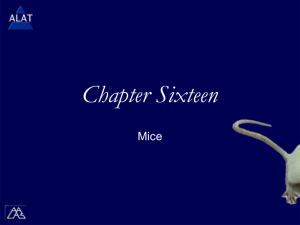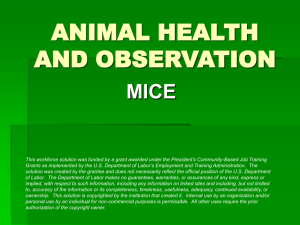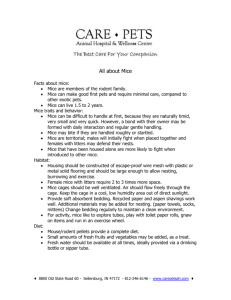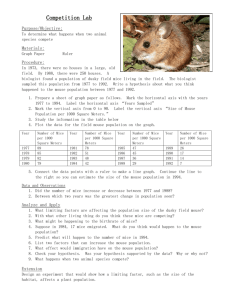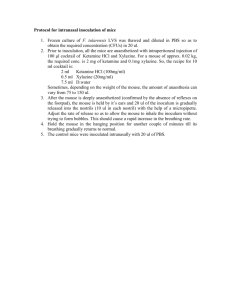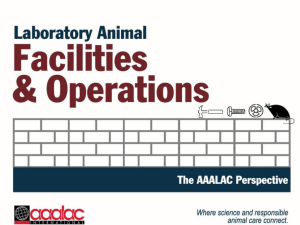Chapter 9: Design and Management of Research
advertisement
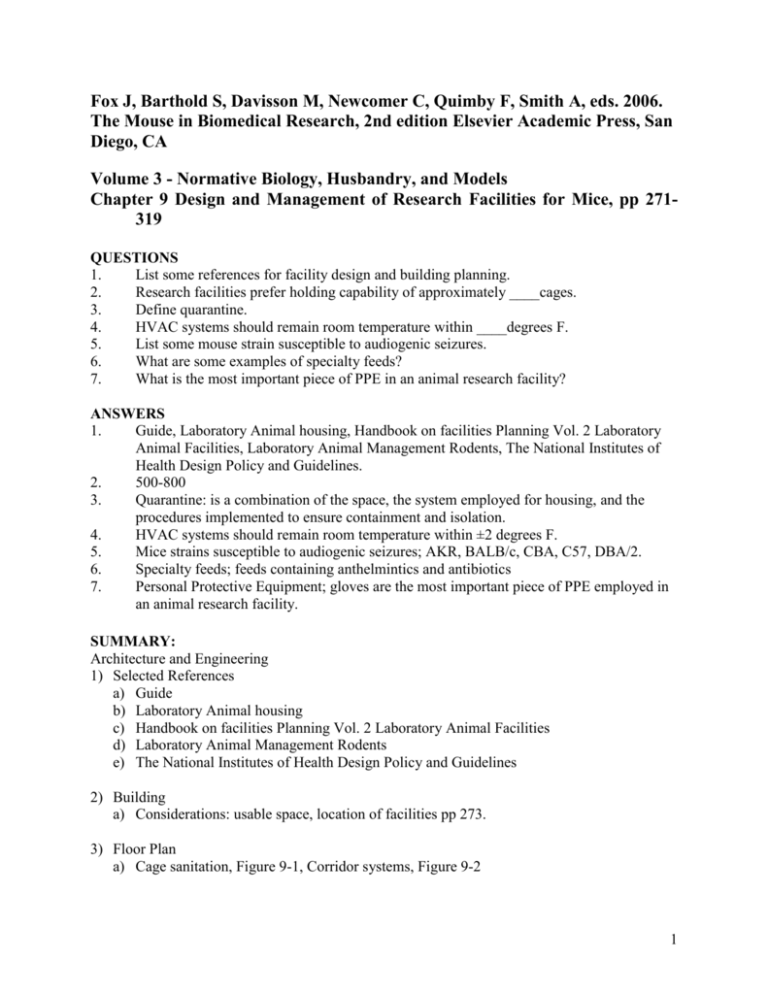
Fox J, Barthold S, Davisson M, Newcomer C, Quimby F, Smith A, eds. 2006. The Mouse in Biomedical Research, 2nd edition Elsevier Academic Press, San Diego, CA Volume 3 - Normative Biology, Husbandry, and Models Chapter 9 Design and Management of Research Facilities for Mice, pp 271319 QUESTIONS 1. List some references for facility design and building planning. 2. Research facilities prefer holding capability of approximately ____cages. 3. Define quarantine. 4. HVAC systems should remain room temperature within ____degrees F. 5. List some mouse strain susceptible to audiogenic seizures. 6. What are some examples of specialty feeds? 7. What is the most important piece of PPE in an animal research facility? ANSWERS 1. Guide, Laboratory Animal housing, Handbook on facilities Planning Vol. 2 Laboratory Animal Facilities, Laboratory Animal Management Rodents, The National Institutes of Health Design Policy and Guidelines. 2. 500-800 3. Quarantine: is a combination of the space, the system employed for housing, and the procedures implemented to ensure containment and isolation. 4. HVAC systems should remain room temperature within ±2 degrees F. 5. Mice strains susceptible to audiogenic seizures; AKR, BALB/c, CBA, C57, DBA/2. 6. Specialty feeds; feeds containing anthelmintics and antibiotics 7. Personal Protective Equipment; gloves are the most important piece of PPE employed in an animal research facility. SUMMARY: Architecture and Engineering 1) Selected References a) Guide b) Laboratory Animal housing c) Handbook on facilities Planning Vol. 2 Laboratory Animal Facilities d) Laboratory Animal Management Rodents e) The National Institutes of Health Design Policy and Guidelines 2) Building a) Considerations: usable space, location of facilities pp 273. 3) Floor Plan a) Cage sanitation, Figure 9-1, Corridor systems, Figure 9-2 1 4) Holding Room a) Research facilities prefer holding capability of approximately 500-800 cages. b) Note the two commonly utilized room configurations, Figure 9-3, pp. 276. 5) Cage Sanitation Area a) Centralized vs. Decentralized b) Separation of clean and soiled activities 6) Procedures Laboratories 7) Specialized Facilities a) Quarantine: is a combination of the space, the system employed for housing, and the procedures implemented to ensure containment and isolation. Figure 9-5. i) Primary or cage level containment, pp 278. 8) Hazardous Agent Containment a) Biosafety levels (BSLs) 1 through 4 b) HEPA Filters c) Adherence to Nuclear Regulatory Commission standards d) Biological safety cabinets, Figure 9-6, 9-7. 9) Necropsy a) Downdraft tables, Biological safety cabinets 10) Imaging a) Magnetic Resonance imaging, magnetic resonance spectroscopy, position emissions tomography, single photon emission computed tomography, ultrasound, computed tomography ect. pp. 282. b) Location, sanitation, transportation of animals 11) Support Areas a) Animal receiving areas should be designed and operated to minimize the contamination of incoming mice. b) “Pass-through” receiving suite. Figure 9-8. c) Automation i) Foundry robots, Figure 9-9. pp. 286. ii) Automatic Watering Systems, quick disconnect (QD) fittings, Figure 9-10. iii) Bottle filling equipment, automated bottle handling systems, Figure 9-11, Figure 912. 12) Microenvironment a) HVAC system, single most expensive component of modern vivarium, pp. 288-290. b) Holding room; proper ventilation to handle animal heat load. c) Holding room temperature; 72-74 degrees, for hairless and nude mice, 78-82 degrees. d) HVAC systems should remain room temperature within ±2 degrees F. e) Relative humidity; zone vs. room systems, zone systems are preferred. f) Considerations; air duct patterns and location. 2 g) Lighting; 12-h light: 12-h dark is the most common; 14-h light is preferred by some breeding facilities, pp. 291-292. h) Noise; mice communicate using ultrasonic frequencies >20 kHz. Mice strains susceptible to audiogenic seizures; AKR, BALB/c, CBA, C57, DBA/2. FVB mice have been shown to develop an often lethal epileptic syndrome triggered by noise. i) NIH’s Design Policy and Guidelines recommends that animal holding rooms not exceed noise criteria (NC)-40. j) Environmental Monitoring; automated systems, pp.292. 13) Microenvironment; physical environment to which the mouse is exposed a) Review guidelines on acceptable levels of ammonia, carbon dioxide ect. 14) Equipment a) Caging Systems-review pp. 294-299. b) Static vs. Ventilated caging systems (Figure 9-14). c) Isolators; Rigid, flexible, bio bubbles-review, see Chapter 7 on gnotobiology. d) Mass Air Displacement Units, Changing Stations, Biological Safety Cabinets e) Review Figures 9-15 through 9-15, understand working principles of these units. f) Mechanical Washing Equipment and Sterilizers i) Mechanical washing equipment is fundamental to cage, bottle, and equipment sanitation. ii) Batch Washers, review sterilization times, pp. 302. 15) Materials a) Feed; high-quality feed is essential b) Know the differences and uses for Closed, Open, Irradiated, Purified, Autoclavable, Certified diets, pp. 304-305. c) Specialty feeds; feeds containing anthelmintics and antibiotics d) Holding requirements; feeds should be maintained under cool and dry conditions. 16) Bedding a) Know different types of bedding and the pros and cons for their use. Example; Corncob bedding-inhibits ammonia accumulation but is abrasive to skin of immunocompromised mouse strains. b) Certified bedding; has specific toxins and environmental contaminates are below a specified levels, used in GLP studies. 17) Water a) Compliance with the Safe Water Drinking Act b) Contaminants; bisphenol A (BPA)-estrogenic activity. c) Acidification, Chlorination, pp. 306-309. 18) Chemicals; A variety of chemicals are routinely employed in the daily operation of a vivarium. a) Detergents, acids, disinfectants pp. 309-311. 3 19) Operational Issues, pp. 331-314. a) Levels of Exclusion; physical/ operational barriers. b) Material Transport; Clean gage wash (CCW) and soiled cage wash (SCW). c) Personnel Flow d) Animal Receipt and Transport e) Personal Protective Equipment; gloves are the most important piece of PPE employed in an animal research facility. i) Latex Allergies; delayed hypersensitivity + type 4, immediate hypersensitivity = type 1. 20) Environmental Enrichment a) The addition of nesting material to mouse cages decreases aggression. 4


